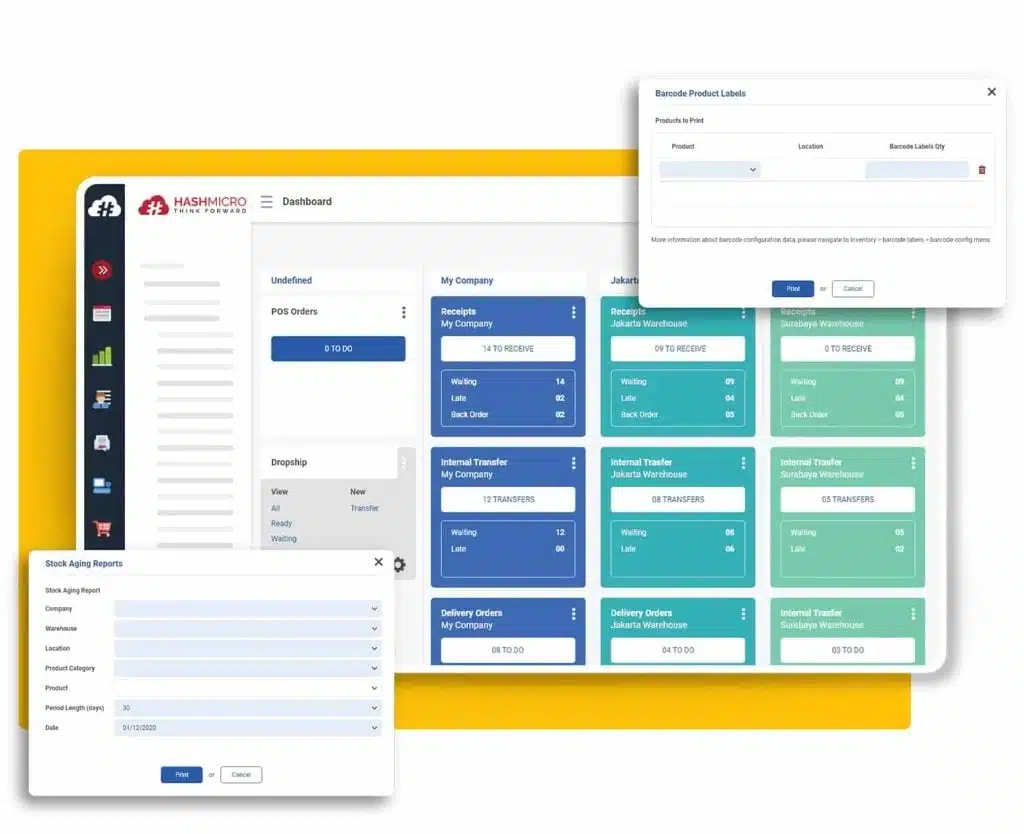Managing a warehouse can be challenging. Are you looking for ways to fix inefficiencies that affect your profits? Due to bad warehouse management, many businesses worry about lost inventory, late shipments, and unhappy customers.
Warehouse operations involve many tasks, like inventory control and order fulfilment. Poor management can create disorganization, resulting in financial losses and damaging reputations. In today’s competitive market, these issues can be very damaging.
What is warehouse management? It refers to the processes overseeing the storage and movement of goods within a warehouse. Implementing effective strategies and a warehouse management system can help mitigate common problems.
Tuklasin natin kung ano ang kasama sa epektibong pamamahala ng warehouse!
Table of Contents
Key Takeaways
|
What is Warehouse Management?
Warehouse management involves overseeing the entire storage and distribution process within a warehouse. It encompasses various activities, including receiving, inventory management, order fulfilment, and shipping. The goal is to optimize efficiency while minimizing costs.
Critical components of warehouse management include inventory tracking, space utilization, and process automation. By implementing effective strategies, businesses can ensure that products are stored correctly and retrieved promptly, enhancing overall operational efficiency.
In essence, warehouse management is not just about storing goods; it’s about creating a systematic approach that improves workflow and accuracy. A well-managed warehouse is crucial for meeting customer demands and driving business growth.
Warehouse management system examples include HashMicro, SAP, Oracle, and Fishbowl.
Benefits of Effective Warehouse Management

Effective warehouse management is crucial for boosting operational efficiency and keeping customers happy. Here’s how it can make a significant impact:
1. Improved accuracy
Keeping accurate inventory records helps minimize errors, ensuring customers get the right products. This reliability builds trust, which is essential for customer loyalty. When customers know they can rely on a business for timely and accurate deliveries, they’re more likely to return and recommend the service to others.
2. Reduced costs
Streamlining warehouse operations can lead to significant savings in labour and storage expenses. Efficient processes help manage resources better, reducing waste and unnecessary costs.
For example, optimizing picking routes can save time and labour hours. These cost reductions boost profitability and provide opportunities for reinvestment in the business.
3. Enhanced customer satisfaction
Timely deliveries and precise order fulfilment greatly improve customer satisfaction. When orders arrive as expected, it creates a positive experience that encourages customers to return.
Happy customers will also likely share their experiences, leading to valuable word-of-mouth referrals. In a competitive market, high customer satisfaction can set a business apart.
In short, effective warehouse management goes beyond just improving efficiency. It’s about building a solid foundation for long-term success through accuracy, cost savings, and satisfied customers.
Types of Warehouse Management Systems
Understanding the various warehouse management systems (WMS) types is essential, as each comes with distinct advantages suited to different business requirements. Choosing the right system can significantly influence operational efficiency and overall performance. Here are some key warehouse process:
1. Cloud-based WMS
Cloud-based systems provide flexibility and scalability, enabling businesses to access data from anywhere. They minimize the need for extensive IT infrastructure, making them a cost-effective option for many organizations.
2. On-premise WMS
These systems are installed on local servers, allowing businesses full control over their data. While they typically involve higher initial costs, organizations with specific security and compliance needs often prefer on-premise systems.
3. Integrated systems
Integrated warehouse management systems combine WMS with other business applications, such as Enterprise Resource Planning (ERP). This integration streamlines operations across various departments, improving communication and ensuring data consistency throughout the organization.
By carefully evaluating these options, businesses can select a WMS that aligns with their operational goals and enhances overall productivity.
Fundamental Processes in Warehouse Management

Understanding the critical processes in warehouse management is essential for ensuring smooth operations and customer satisfaction. Each step contributes to overall efficiency, helping businesses meet demand and minimize errors.
1. Receiving
Receiving is the first step in warehouse management. It involves inspecting incoming goods, updating inventory systems, and organizing items for storage. Efficient management minimizes discrepancies and ensures accurate inventory records.
2. Storage
Practical storage maximizes space and provides easy access to products. Appropriate storage systems and slotting techniques enhance organization, ensuring high-demand items are easily retrievable.
3. Slotting
Slotting is the strategic inventory placement within the warehouse to optimize retrieval and storage efficiency. By analyzing item popularity and dimensions, businesses can position high-demand products closer to picking areas, reducing travel time and improving workflow.
4. Picking
Picking involves selecting items for customer orders and directly affects speed and accuracy. Employing batch or zone-picking methods and technology such as barcode scanners can streamline this process and reduce errors.
5. Packing
Packing ensures items are securely prepared for shipping, minimizing damage during transit. Labelling and standardized packing procedures help maintain consistency and improve processing efficiency at delivery points.
6. Shipping
Shipping is the final step, where goods are dispatched to customers. Efficient shipping operations reduce lead times and ensure products arrive in optimal condition, enhancing overall customer satisfaction.
7. Reporting
Reporting involves analyzing warehouse data to monitor performance and identify areas for improvement. Regular reporting helps businesses track key metrics, such as order accuracy and inventory turnover, enabling informed decision-making and strategic planning.
WMS vs Inventory Management: Understanding the Difference
Warehouse management systems (WMS) and inventory management systems serve distinct purposes but complement each other. WMS focuses on day-to-day operations within the warehouse and optimizes storage and fulfilment processes, particularly in a warehouse storage system.
In contrast, inventory management systems track stock levels, orders, and deliveries across the supply chain. While WMS enhances warehouse efficiency, inventory systems provide a broader view of product movement, ensuring that stock levels align with demand.
By integrating these systems, businesses can develop a streamlined strategy for managing their products. This cohesive operation improves supply chain oversight, reduces costs, and enhances service quality.
Core Principles of Warehouse Management
Grasping the core principles of warehouse management is essential for optimizing operations and enhancing customer satisfaction. Each principle contributes uniquely to creating a thriving warehouse environment.
1. Understand your goals
It’s essential to define the specific aims of your warehouse operations clearly. This includes assessing customer delivery needs and specialized storage requirements and maximizing space, labour, and equipment use.
2. Holistic oversight
Managing the intricate processes involving personnel, equipment, orders, and inventory is critical. Monitoring each aspect ensures smooth operations and allows for timely resolutions to any challenges, maintaining quality control for accurate order fulfilment.
3. Adaptability and resilience
The ability to quickly adjust plans in response to unexpected issues, such as damaged goods or adverse weather conditions, is crucial. Modifying workflows can enhance efficiency through strategic rearrangements or innovative picking methods.
4. Customer-centric approach
Delivering the right product on time is vital for ensuring customer satisfaction. Rapid and precise order fulfilment is key to meeting customer expectations effectively.
5. Data-driven decision making
Implementing a Warehouse Management System (WMS) offers real-time insights into inventory levels, helping to identify areas for improvement. Regular data analysis supports process optimization and boosts operational efficiency.
Looking for a warehouse management system Philippines? Hashmicro is your solution! Huwag mag-atubiling makipag-ugnayan sa amin!
Discover HashMicro for Advanced Warehouse Management

Discover HashMicro’s advanced Warehouse Management System (WMS) to transform your logistics operations. Designed to streamline and automate processes, HashMicro offers features like real-time inventory tracking, efficient order fulfilment, and customizable workflows.
With seamless integration into existing business systems, HashMicro provides a comprehensive solution for optimizing warehouse operations. Experience improved efficiency through advanced technologies such as RFID, barcode scanning, and various picking methods tailored to your needs.
Features:
- RFID Warehouse Rack Stock In-Out Automation: Enhances accuracy and efficiency by automating stock tracking with RFID technology.
- 3D Warehouse: Provides a visual layout and inventory status, aiding space optimization and strategic planning.
- OCR for Receiving: Speeds up receiving processes by automatically converting physical documents to digital data.
- Stock Forecasting: Analyzes demand to reduce overstock and stockouts, improving inventory management and customer satisfaction.
- Run Rate Reordering Rules: Ensures efficient stock management by setting replenishment rules based on actual demand.
- Quality Control Management: Guarantees products meet quality standards, enhancing customer satisfaction and reducing defects.
- Pick, Pack, Delivery (3-Step Route Warehousing) Streamlines the processes of picking, packing, and delivering goods for faster operations.
Itaas ang iyong pamamahala sa bodega mula sa HashMicro!

Conclusion
Effective warehouse management is crucial in today’s competitive landscape. HashMicro offers solutions that simplify inventory tracking and optimize space utilization. Are you struggling with discrepancies or slow orders? Our software can tackle these challenges head-on.
HashMicro’s warehouse management software gives you real-time visibility into inventory levels and movements. Our intuitive platform streamlines operations, reduces errors, and boosts productivity, allowing you to focus on strategic decision-making for maximum efficiency.
Ready to enhance your warehouse operations? HashMicro provides tailored solutions to meet your unique needs. Mag-sign up ngayon para sa isang libreng demo!

FAQ
-
What is a Warehouse Management System (WMS)?
A Warehouse Management System (WMS) is software that helps manage and optimize warehouse operations, including inventory tracking, order fulfillment, and shipping processes.
-
How does a WMS benefit warehouse businesses?
A WMS enhances efficiency, reduces errors, improves inventory accuracy, and streamlines operations, leading to cost savings and better customer service.
-
Why is a WMS essential?
A WMS is crucial for maintaining organization, maximizing space utilization, and ensuring timely deliveries, which are vital for competitive advantage in logistics.




































